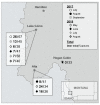Continuing Orthohantavirus Circulation in Deer Mice in Western Montana
- PMID: 34072112
- PMCID: PMC8226622
- DOI: 10.3390/v13061006
Continuing Orthohantavirus Circulation in Deer Mice in Western Montana
Abstract
Hantavirus pulmonary syndrome (HPS) is an often-fatal disease caused by New World hantaviruses, such as Sin Nombre orthohantavirus (SNV). In the US, >800 cases of HPS have been confirmed since it was first discovered in 1993, of which 43 were reported from the state of Montana. The primary cause of HPS in the US is SNV, which is primarily found in the reservoir host Peromyscus maniculatus (deer mouse). The reservoir host covers most of the US, including Montana, where multiple studies found SNV in local deer mouse populations. This study aimed to check the prevalence of SNV in the deer mice at popular recreation sites throughout the Bitterroot Valley in Western Montana as compared to previous studies in western Montana. We found high prevalence (up to 20%) of deer mice positive for SNV RNA in the lungs. We were unable to obtain a SNV tissue culture isolate from the lungs but could passage SNV from lung tissue into naïve deer mice. Our findings demonstrate continuing circulation of SNV in western Montana.
Keywords: Bitterroot Valley; Montana; Peromyscus maniculatus; Sin Nombre orthohantavirus; genome detection; lung.
Conflict of interest statement
The authors declare no conflict of interest.
Figures


References
-
- Childs J.E., Ksiazek T.G., Spiropoulou C.F., Krebs J.W., Morzunov S., Maupin G.O., Gage K.L., Rollin P.E., Sarisky J., Enscore R.E., et al. Serologic and genetic identification of Peromyscus maniculatus as the primary rodent reservoir for a new hantavirus in the southwestern United States. J. Infect. Dis. 1994;169:1271–1280. doi: 10.1093/infdis/169.6.1271. - DOI - PubMed
Publication types
MeSH terms
Substances
Grants and funding
LinkOut - more resources
Full Text Sources
Medical

